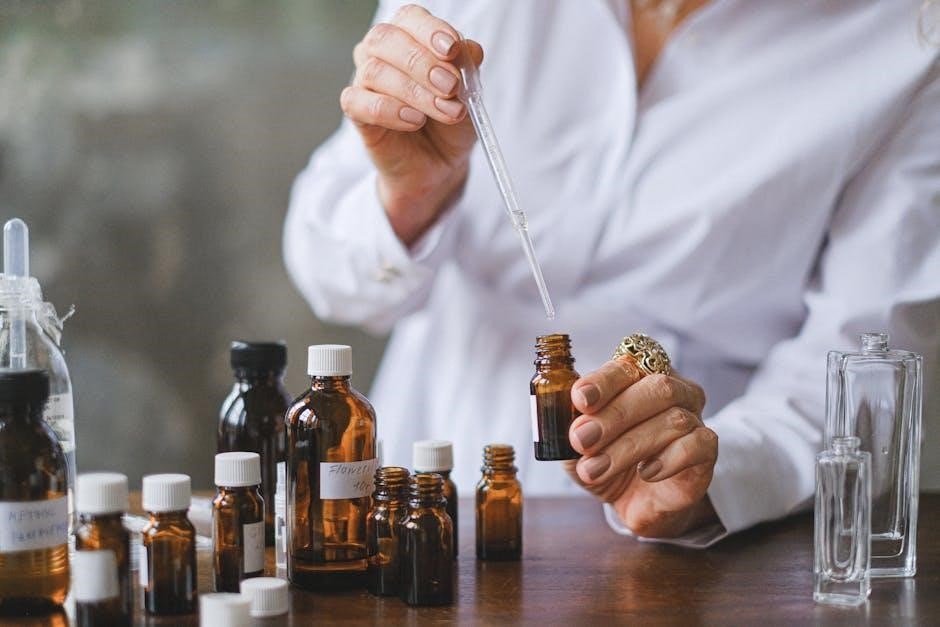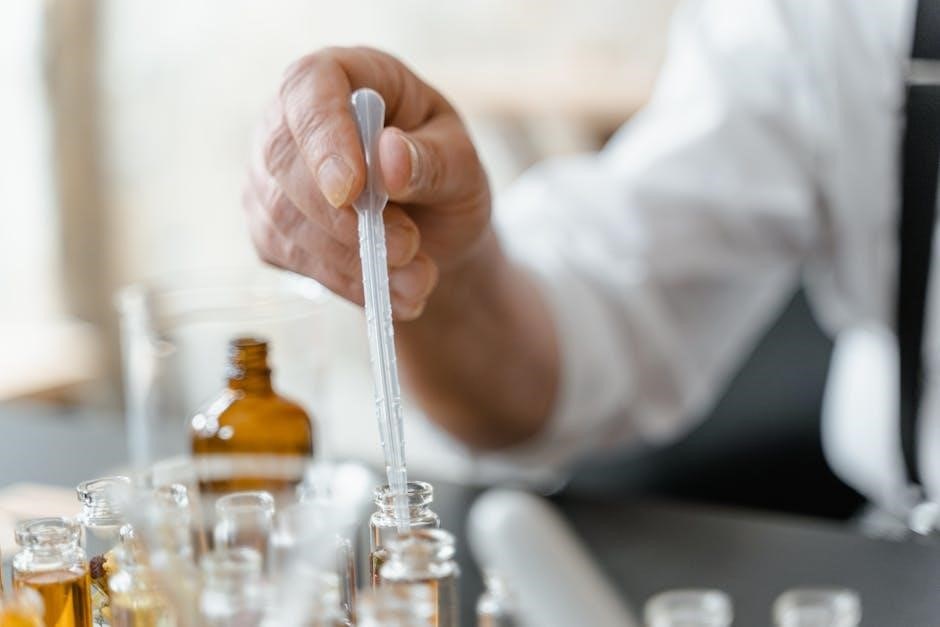
bifenthrin 7.9 mixing instructions
Bifenthrin 7․9 is a synthetic pyrethroid insecticide‚ acaricide‚ and termiticide‚ widely used for controlling pests like ants‚ mosquitoes‚ and termites․ Its effectiveness lies in its ability to disrupt the nervous system of pests‚ providing quick knockdown and long-lasting residual control․ Available in liquid concentrate form‚ it is commonly applied in agricultural‚ residential‚ and public health settings․ Proper mixing is essential to ensure safety‚ efficacy‚ and environmental compliance‚ making it a versatile and reliable solution for various pest management needs․
What is Bifenthrin 7․9?
Bifenthrin 7․9 is a synthetic pyrethroid insecticide‚ commonly used for pest control in agricultural‚ residential‚ and public health settings․ It is formulated as a liquid concentrate‚ containing 7․9% bifenthrin by weight‚ and is effective against a wide range of pests‚ including ants‚ termites‚ mosquitoes‚ and ticks․ Known for its rapid knockdown and residual activity‚ it works by disrupting the nervous system of target pests․ Bifenthrin 7․9 is a popular choice due to its versatility and ability to provide long-lasting control when applied correctly․
Importance of Proper Mixing Instructions
Proper mixing of Bifenthrin 7․9 is crucial for ensuring optimal effectiveness‚ safety‚ and environmental compliance․ Incorrect dilution can lead to reduced efficacy‚ potential harm to non-target organisms‚ or unintended environmental contamination․ Following the recommended mixing ratios and procedures guarantees the product performs as intended‚ minimizing risks to people‚ pets‚ and plants․ Adhering to the guidelines also prevents over-application‚ which can waste product and pose health hazards․ Always consult the product label or dilution charts for precise instructions to achieve the best results while maintaining safety standards․

General Mixing Directions for Bifenthrin 7․9
Fill the tank with water‚ add the recommended amount of Bifenthrin 7․9‚ and mix thoroughly for uniform distribution․ Always follow label instructions for precise measurements․
Step-by-Step Mixing Process
Fill the mixing tank halfway with water to reduce splashing․ Add the required amount of Bifenthrin 7․9 concentrate‚ ensuring accurate measurement․ 2․ Agitate the mixture thoroughly to dissolve the product evenly․ 3․ Add the remaining water to the tank and mix again․ 4․ Allow the mixture to sit briefly before application to ensure uniform distribution․ For foam applications‚ apply Bifenthrin 7․9 concentrate at the recommended rate without dilution․ Always refer to the product label for specific instructions tailored to your application needs․
Recommended Mixing Ratios
For most applications‚ mix 0․5 to 1․0 fluid ounces of Bifenthrin 7․9 per gallon of water․ For subterranean termites‚ use a 0․06 emulsion rate․ When targeting nuisance ants or mosquitoes‚ apply 0․5 to 1․0 fl oz per gallon‚ delivering one gallon per 1‚000 square feet․ For lawn and ornamental use‚ mix 1 oz of product per gallon of water per 1‚000 sq ft․ Always adhere to the label’s specified rates to avoid over-application and ensure effective pest control while minimizing environmental impact․
Importance of Dilution Charts
Dilution charts are essential for achieving the correct concentration of Bifenthrin 7․9‚ ensuring both safety and efficacy․ They provide precise guidelines for mixing‚ preventing over-application or under-application․ Proper dilution ensures the product remains effective against pests while minimizing environmental impact․ Referencing these charts helps avoid hazards to humans‚ pets‚ and beneficial organisms․ They also ensure compliance with label instructions and regulatory requirements․ Always consult the dilution chart for specific pest control scenarios to achieve optimal results and maintain safety standards during application․
Safety Precautions and Protective Equipment
Wear gloves‚ goggles‚ and a mask when handling Bifenthrin 7․9 to prevent skin contact and eye exposure․ Avoid breathing vapors and ensure proper ventilation․ Keep first aid measures ready in case of accidental exposure or ingestion․
Necessary Protective Gear
When mixing Bifenthrin 7․9‚ essential protective gear includes gloves‚ safety goggles‚ and a face mask to prevent skin contact and inhalation of vapors․ Long sleeves and closed-toe shoes are also recommended to minimize exposure․ Ensure all equipment is in good condition to avoid accidental spills or leaks․ Proper protective gear helps prevent potential health risks associated with pesticide handling․ Always follow label instructions for additional safety measures to ensure safe and effective application․ Proper attire is crucial for safeguarding against chemical exposure during mixing and application processes․
Safe Handling Practices
Always follow label instructions for safe handling of Bifenthrin 7․9․ Wear protective gear and ensure the area is well-ventilated to prevent inhalation of vapors․ Avoid skin contact and wash hands thoroughly after handling․ Mix the product in a clean‚ dedicated area away from food and water sources․ Use the correct dilution rates and avoid over-application to prevent environmental contamination․ Shake or stir the mixture well to ensure even distribution of the active ingredient․ Proper handling practices minimize health risks and ensure effective pest control while maintaining safety for people‚ pets‚ and the environment․
First Aid Measures
If exposure occurs‚ initiate first aid immediately․ For skin contact‚ wash the affected area with soap and water․ In case of eye exposure‚ flush with clean water for at least 15 minutes․ If inhaled‚ move the person to fresh air and provide oxygen if breathing is difficult․ Do not induce vomiting if ingested unless instructed by a healthcare professional․ Seek medical attention promptly for any severe symptoms․ Proper first aid ensures minimal health risks and promotes recovery from accidental exposure to Bifenthrin 7․9․

Application Rates and Methods
Application rates vary by pest‚ with 0․5-1․0 fl oz per gallon for mosquitoes and 1 oz per 1‚000 sq ft for lawns․ Methods include spraying‚ brushing‚ and foam applications for targeted pest control in shrubs‚ grass‚ and standing water areas․
Application Rates for Different Pests
For mosquito and outdoor pest control‚ use 0․5–1․0 fl oz per gallon of water‚ applied to shrubs‚ grass‚ and standing water areas․ Lawn applications require 1 oz per 1‚000 sq ft․ Subterranean termites need a 0․06 emulsion rate․ Nuisance ants and carpenter ants are controlled with 0․5–1․0 fl oz in one gallon of water‚ applied at 1 gallon per 1‚000 sq ft․ Aphids‚ ants‚ and armyworms fall under similar general pest control rates‚ ensuring targeted and effective treatment․
Methods of Application
Bifenthrin 7․9 is typically applied as a spray‚ brush‚ or foam treatment․ For outdoor pest control‚ spray applications target shrubs‚ grass‚ and standing water․ Brush applications are suitable for localized infestations․ Foam applications are used for termite control in wall voids․ Use calibrated equipment like backpack sprayers or power sprayers for uniform coverage․ Apply to specific areas such as trails‚ doors‚ windows‚ and foundation perimeters․ Avoid spray drift onto non-target surfaces to ensure environmental safety and effective pest management․ Always follow label instructions for optimal results․
Outdoor vs․ Indoor Applications
Bifenthrin 7․9 is versatile for both outdoor and indoor pest control․ Outdoor applications often target larger areas like lawns‚ shrubs‚ and perimeters‚ using spray or foam treatments to combat pests such as mosquitoes and ants․ Indoors‚ it is applied to cracks‚ crevices‚ and walls for targeted pest control‚ like nuisance ants and termites․ Always adjust application rates based on the location and pest type to ensure effectiveness and safety․ Follow label instructions to avoid over-application and potential environmental impact․

Mixing for Specific Uses
Bifenthrin 7․9 mixing varies by application type‚ such as lawn‚ ornamental‚ mosquito‚ or termite control․ Adjust concentrations and volumes based on target pests and application areas․
Mixing for Lawn and Ornamental Applications
For lawn and ornamental applications‚ mix 1 oz of Bifenthrin 7․9 per gallon of water per 1‚000 square feet․ Shake or stir thoroughly for even distribution․ Apply to grass‚ shrubs‚ and ornamental plants to control pests like aphids‚ ants‚ and armyworms․ Ensure proper coverage without over-application to avoid harming plants or beneficial insects․ Always refer to the dilution chart for specific ratios tailored to your target pest and application area․
Mixing for Mosquito and Outdoor Pest Control
For mosquito and outdoor pest control‚ mix 0․5 to 1․0 fl oz of Bifenthrin 7․9 per gallon of water․ Apply this solution to shrubs‚ grass‚ and standing water areas where mosquitoes breed․ Shake the mixture well before use to ensure even distribution․ Apply one gallon of the diluted mixture per 1‚000 square feet․ This method effectively targets mosquitoes and other outdoor pests‚ providing residual control․ Always refer to the dilution chart for precise application rates and follow safety guidelines to minimize environmental impact․
Mixing for Termite Control
For termite control‚ mix Bifenthrin 7․9 at a rate of 0․06 emulsion‚ which equates to 3 quarts of product per 100 gallons of water․ This dilution ensures effective control of subterranean termites․ Proper mixing is critical to achieve the desired concentration and prevent environmental contamination․ Apply the mixture through soil treatment or direct injection into termite mounds․ Uniform application is essential to ensure complete coverage and prevent re-infestation․ Always refer to the product label for specific application instructions and safety guidelines․

Equipment Setup and Calibration
Calibrate equipment to ensure accurate application rates․ Proper setup maintains correct mixing ratios‚ preventing under or over-application․ Regular checks ensure safety and efficacy in pest control treatments․
Choosing the Right Equipment
Selecting appropriate equipment is crucial for effective Bifenthrin 7․9 application․ Use high-quality sprayers or foam generators designed for pesticide application․ For spray applications‚ choose equipment that ensures uniform coverage․ Foam generators are ideal for termite control in tight spaces․ Consider the size of the area and pest type when selecting equipment․ Always follow manufacturer guidelines for compatibility and safety․ Proper equipment ensures accurate mixing and application‚ minimizing waste and environmental impact․ Consult product labels for specific equipment recommendations to optimize results․
Calibrating Equipment for Accurate Application
Calibrating equipment ensures accurate application of Bifenthrin 7․9‚ preventing overuse or underuse․ Measure the output rate and adjust nozzles or flow settings to meet the recommended rate․ Test by collecting output in a measured container over a set time‚ using a stopwatch․ Follow manufacturer guidelines for specific instructions․ Proper calibration ensures consistent results‚ reduces waste‚ and aids in complying with safety and environmental regulations․ Regular checks maintain accuracy and effectiveness․
Storage and Disposal Instructions
Store Bifenthrin 7․9 in its original container‚ in a cool‚ dry place‚ away from light and out of reach of children and pets․ Dispose of unused product and rinse empty containers according to local regulations‚ ensuring environmental safety and compliance with legal requirements․
Proper Storage Conditions
Store Bifenthrin 7․9 in its original container‚ tightly sealed‚ in a cool‚ dry‚ well-ventilated area away from direct sunlight and moisture․ Keep the product away from heat sources‚ open flames‚ and incompatible chemicals․ The ideal storage temperature is between 40°F and 90°F (4°C and 32°C)․ Ensure the container is inaccessible to children‚ pets‚ and unauthorized personnel․ Do not store in areas prone to flooding or where contamination could occur․ Always follow the label instructions for storage to maintain product stability and safety․
Disposal of Unused Product and Containers
Dispose of unused Bifenthrin 7․9 and its containers in accordance with local‚ state‚ and federal regulations․ Do not pour the product down drains or sewers‚ as it may contaminate waterways․ Triple rinse empty containers with water and recycle them if permitted․ Ensure all rinsate is included in the disposal process․ Contact a licensed waste disposal facility for proper handling of hazardous waste; Never reuse containers for other purposes․ Always follow environmental guidelines to minimize ecological impact and ensure compliance with safety standards․
Troubleshooting Common Mixing Issues
Common mixing issues include improper dilution‚ sediment formation‚ or equipment clogging․ Ensure accurate measurements‚ thorough stirring‚ and proper equipment maintenance to avoid these problems effectively․
Common Mistakes to Avoid
- Improper dilution ratios‚ leading to reduced efficacy or environmental contamination․
- Not shaking the concentrate well‚ causing uneven distribution of active ingredients․
- Applying incorrect rates‚ which can result in ineffective pest control or safety hazards․
Avoiding these errors ensures safe and effective pest management‚ emphasizing the importance of precise mixing and application․
Fixing Uneven Mixtures
If an uneven mixture occurs‚ shake the tank thoroughly or use agitation systems to ensure uniform distribution of Bifenthrin 7․9․ Check for settled particles at the bottom of the container and re-agitate if necessary․ Avoid applying uneven mixtures‚ as this can lead to reduced efficacy or over-application in certain areas․ Proper agitation ensures consistent pest control and minimizes environmental risks․ Always monitor the mixture before and during application to maintain optimal performance and safety standards․
Properly mixing and applying Bifenthrin 7․9 is essential for effective pest control and safety․ Always follow the recommended dilution rates and application methods to avoid overuse or uneven distribution․ Regular agitation of the mixture ensures consistency‚ while proper storage and disposal practices protect the environment․ Whether for lawns‚ ornamentals‚ or termites‚ Bifenthrin 7․9 remains a reliable solution when used correctly․ By adhering to the guidelines outlined‚ users can achieve optimal results while minimizing risks to humans‚ pets‚ and the ecosystem․